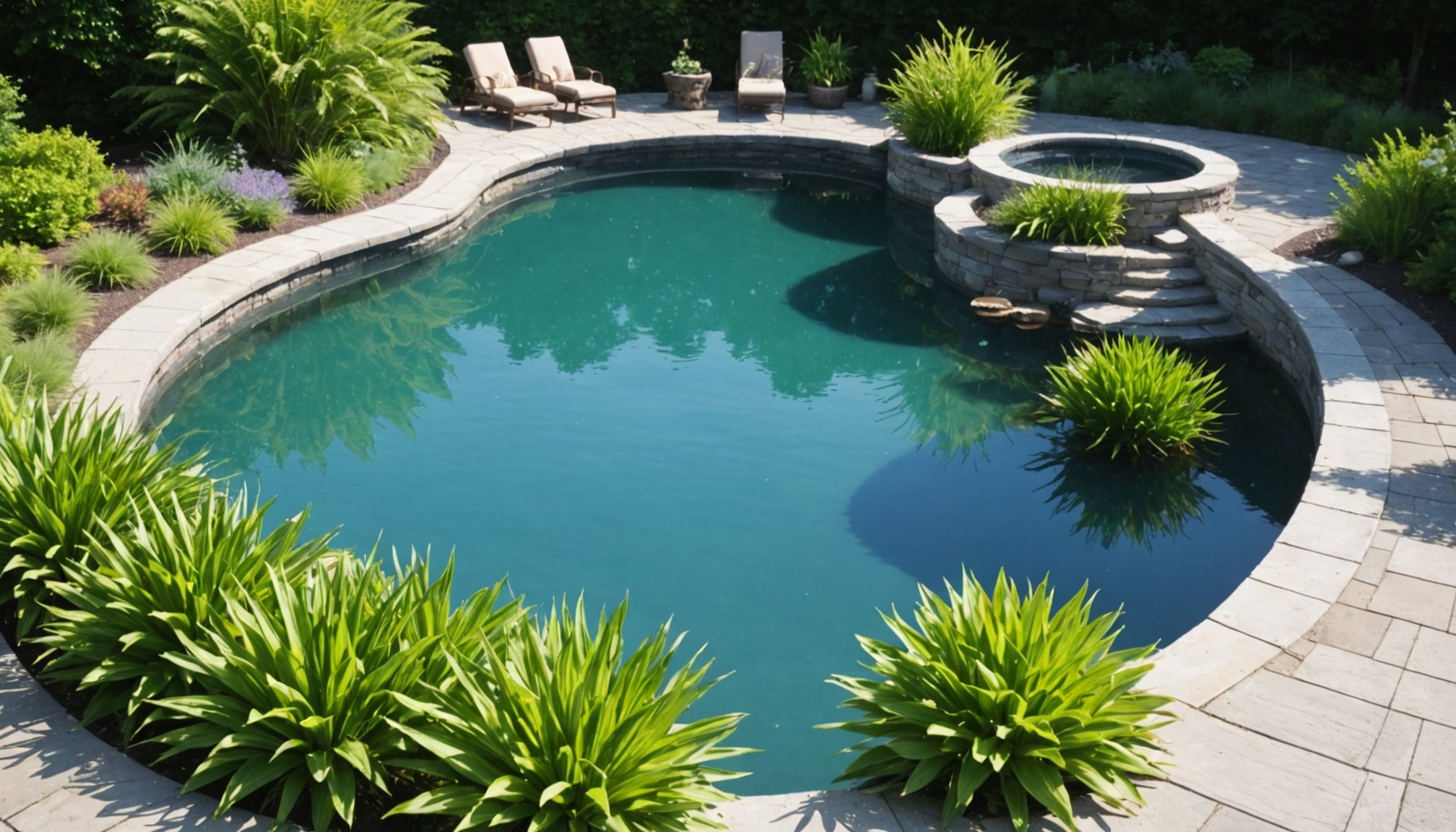Benefits of Using Aquatic Plants for Water Quality
Aquatic plants play a significant role in enhancing water quality through natural mechanisms. One of their primary functions is natural filtration, where their root systems absorb excess nutrients from the water. This nutrient absorption helps prevent the growth of unwanted algae, leading to clearer and healthier water. Furthermore, aquatic plants assist in balancing the ecosystem by absorbing pollutants and toxins, increasing overall water quality improvement.
In addition to improving water quality, aquatic plants contribute to the aesthetics of a pool area. They create a serene and natural environment that enhances the user’s experience. The presence of lush greenery around a pool not only provides shade and a pleasing appearance but also promotes relaxation and tranquility.
Also to see : Transform Your UK Home: Innovative Ways to Create a Relaxing Seating Area by the Pool
However, the benefits of aquatic plants extend beyond their soothing aesthetics. By integrating these plants into a pool setting, a natural filtration system is created, reducing the need for chemical treatments. This contributes to a more sustainable pool maintenance practice, aligning with environmentally friendly approaches. Through effective use of these plants, pool owners can achieve both practical and aesthetic benefits, creating a harmonious balance between natural beauty and functional excellence.
Methods of Integrating Aquatic Plants into Pool Maintenance
Integrating aquatic plants into pool maintenance involves strategic planning to ensure both pool integration and effective maintenance strategies. Establishing distinct plant zones is a common approach, focusing on submerged, floating, and marginal areas. Each zone serves different purposes: submerged plants provide natural filtration directly in the water, floating plants enhance surface aesthetics, and marginal plants contribute to the ecosystem from the pool’s edges.
Also to read : Transform Your UK Swimming Pool with a Stylish Pool Bar: Tips for Seamless Integration
Aquatic plant installation must be done with care, considering the specific requirements of each plant type. Submerged plants like hornwort and anarcharis are chosen for their efficiency in improving water quality through nutrient absorption. Conversely, floating plants such as water lilies add visual beauty while shading the pool, reducing algae growth. Marginal plants like bamboo or reed grass can also support bank stabilization around pool perimeters.
Maintenance strategies are vital to maintaining the health of these plants. Regular pruning prevents overgrowth, while water quality testing ensures the correct balance of nutrients. Pool owners can benefit from organized planting, effectively leveraging natural processes to enhance pool environments. This multifaceted strategy fosters a sustainable pool ecosystem, blending functionality with natural beauty.
Potential Challenges and Solutions
Incorporating aquatic plants into pool environments can present several challenges, but with the right problem-solving strategies, these issues are manageable. A common concern is algae growth. Algae often compete with aquatic plants for nutrients, leading to murky water. Regular monitoring and balancing of nutrients can mitigate this issue. Additionally, introducing a variety of plant species can help in maintaining the ecological balance, thus reducing the chances of algae taking over.
Managing plant overgrowth is crucial to maintaining the aesthetic appeal and functionality of the pool area. Plants like cattails or excessively large lilies can overwhelm the space if not properly pruned. Regular trimming and thoughtful plant selection ensure a harmonious blend of beauty and functionality without compromising water quality improvement.
Seasonal shifts require maintenance adaptations to keep aquatic plants healthy. In colder months, the metabolic rate of plants slows down, necessitating reductions in fertilisation and careful temperature management. During warmer periods, frequent checks for nutrient levels and water quality can prevent adverse conditions like oxygen depletion. Preparing for these seasonal variations ensures that plants continue to thrive, supporting a balanced ecosystem year-round.
Maintenance Tips for Aquatic Plants
Maintaining healthy aquatic plants requires consistent effort and understanding. Regular inspection is critical to promptly identifying issues such as nutrient deficiencies or disease. Routine checks allow for early intervention and ensure plants continue enhancing your pool’s aesthetic and functionality.
To sustain plant health, focus on nutrient management. Aquatic plants thrive on a balanced nutrient supply, which supports their growth while preventing algae overgrowth. Testing water quality helps maintain this balance, allowing for timely nutrient adjustments as needed. It’s crucial to implement a systematic method for water testing, ensuring that pH levels, nitrates, and phosphates remain within optimal ranges.
Seasonal adjustments play a significant role in plant care. During colder months, reduce fertilisation and monitor water temperature to accommodate slower plant metabolic rates. Conversely, the warmer seasons demand more frequent monitoring to prevent oxygen depletion and excessive nutrient uptake, both of which can negatively impact aquatic plant health.
Consider establishing a maintenance routine that addresses these aspects, ensuring your aquatic plants continue to contribute positively to your pool environment. This approach provides a sustainable framework for embracing the beauty and benefits of aquatic plants while mitigating potential challenges, ultimately promoting a thriving, balanced ecosystem.
Selecting Suitable Aquatic Plants for UK Climates
Choosing the right UK aquatic plants is essential for ensuring they thrive within specific climatic conditions and integrate successfully into pool settings. In the UK, it’s crucial to consider climate suitability and pool compatibility when selecting aquatic plants to avoid potential maintenance headaches.
Characteristics of Ideal Aquatic Plants
Ideal aquatic plants should be adaptable to the UK’s temperate climate, ensuring they can tolerate variations in temperature and light conditions. These plants typically require moderate sunlight and can withstand cooler temperatures, typical of UK weather. Favour native species, as they are well-adapted to local climate and water conditions, and contribute positively to the local ecosystem.
Popular Aquatic Plant Options
For UK climates, some popular choices include marsh marigold and water mint, which are naturally equipped to handle the UK’s weather patterns while adding visual appeal and enhancing biodiversity. These species offer pool compatibility, integrating seamlessly while contributing to water quality through natural filtration and nutrient absorption.
Invasive Species to Avoid
It’s vital to be cautious of invasive species that might disrupt the pool’s ecosystem. Species like Japanese knotweed or floating pennywort can rapidly overtake native plants, complicating maintenance efforts and impacting climate suitability and pool compatibility. Always research thoroughly and opt for plants that support a balanced and sustainable pool environment.
Case Studies and Personal Experiences
Incorporating aquatic plants into real-world settings can inspire and guide those interested in enhancing their pool environments. Examining user experiences can provide a deeper understanding of how these plants deliver sustainable solutions.
Homeowner Success Stories
Many homeowners have shared their success stories, where thoughtful selection of UK aquatic plants has led to enhanced pool compatibility and aesthetic appeal. They report significant improvements in water quality and reduced algae issues, thanks to the natural filtration properties of their plant choices. These first-hand accounts highlight the practical benefits of selecting climate-suitable species, especially when well-integrated into existing ecosystems.
Visual Transformation Through Aquatic Plants
Visual enhancements achieved through the strategic use of aquatic plants can be profound. By selecting species that thrive in local climates, homeowners have witnessed remarkable transformations. One reported instance saw a previously mundane pool area evolve into a lush, vibrant oasis that elevates the surrounding landscape. Before-and-after images often showcase these dramatic changes, serving as a testament to the positive impact of thoughtful plant integration.
Professional Insights and Recommendations
Professionals in the field frequently advocate for thorough research and careful planning when introducing aquatic plants. They recommend focusing on climate suitability and maintaining pool compatibility to avoid common challenges, fostering environments that thrive naturally.











